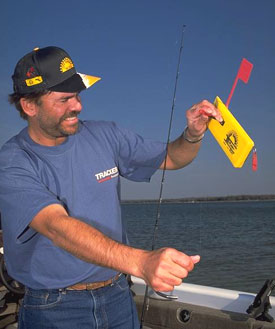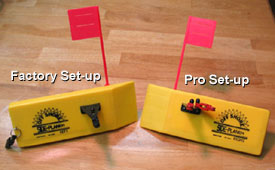 It’s tough for some anglers to think about trolling this time of year. After all, it’s the middle of winter and most lakes are covered with ice. But it’s the ideal time to work on tackle and get yourself ready for the season ahead. If you fish for walleyes, you no doubt have dabbled with some trolling techniques, and if you haven’t, you should. Trolling can often times be the most productive tactic for targeting walleyes and if you troll, more often than not, incorporating boards into your technique will increase your success ten-fold. The key is using the right board and set-up for the conditions at hand, in other words, rigging the perfect trolling board.
It’s tough for some anglers to think about trolling this time of year. After all, it’s the middle of winter and most lakes are covered with ice. But it’s the ideal time to work on tackle and get yourself ready for the season ahead. If you fish for walleyes, you no doubt have dabbled with some trolling techniques, and if you haven’t, you should. Trolling can often times be the most productive tactic for targeting walleyes and if you troll, more often than not, incorporating boards into your technique will increase your success ten-fold. The key is using the right board and set-up for the conditions at hand, in other words, rigging the perfect trolling board.
Of course, the board itself is the base from which you start. The best board we’ve ever used is Off Shore Tackle’s OR12 Side Planer. This board is durable, versatile and ballasted (meaning it’s weighted so that it rides upright in the water even at very slow speeds). The versatility of these boards is what really makes them a great tool for walleye fishing, as well as for trolling other species from trout and salmon to muskies to stripers. The versatility comes in the fact that you can configure these boards with various release clips, release mounting options, flag options and accessories to fit any trolling scenario you would run into.
Right out of the package, the OR12 Side Planers are good trolling boards. They come equipped with a flag for easy spotting, and 2 black OR14 release clips, one mounted on the board’s arm, the other mounted at the rear of the board. If most of your walleye trolling is done on calm water with 10 to 12 pound mono, this may be the only set up you’ll ever need. Let your lure out to the desired distance behind the boat, clip the board in place, and let it out to take the lure off to the side of the boat. When a fish grabs the lure, you’ll see the board begin to “drop back” and you’ll know you have a fish on. Reel the line in up to the board, remove the board and reel in the fish.
Over the years we’ve incorporated a few modifications to this conventional set-up, and feel these changes improve overall board performance for our trolling purposes. The first modification is what we call the “Pro-Set-up”. Here we remove the OR14 releases, as well as the hardware holding the back release. We then use Off Shore Tackle’s heavier tension red OR16 release, placing one at the end of the board’s arm and the other just behind the first one so that it extends off the back of the arm.
The arm on the OR12 boards comes with additional holes already drilled for this modification. The heavier tension clips are great for really holding the line on rough seas and when fighting big fish, and having them both mounted on the arm like this we feel makes the boards easier to “read” (detect when a fish is on the board), as well as making it easier to remove the boards when reeling in a fish. This is especially true in the event that you’re fishing alone and only have one hand available to reach up and detach the board.
The next modification is one we really like and use most often these days, and that is to replace the two OR16 red releases on the arm with one release – an Off Shore Tackle OR18 Snapper Release. This is a great release for anglers trolling with braided lines or a super-line like Berkley FireLine. These types of lines tend to be very slippery and can slip through other release, but the OR18 Snapper Release has a tension adjustment that allows you to set the tension so that this doesn’t happen. And removing the release is easy, since all you do is flip up the tension bracket and the release opens. This is a high-tech modification of the Pro-Set-Up, and is the best rigging we’ve found for anglers that have a tough time removing boards using the OR16 clips.
 The next modification that has proven highly effective over the past few seasons is the use of Off Shore Tackle’s Tattle Flag Upgrade Kit. An OR12 board fitted with the Tattle Flag Kit becomes the ideal board to use when you’re fishing situations that can make “reading” a bite on the board line difficult. These situations would include those times you’re catching smaller sized walleyes, or when you have to deal with other fish such as perch or white bass grabbing your baits as you troll. Often times, smaller fish don’t pull the boards back as well as larger fish, but with the Tattle Flag, the flag itself is pulled down when a fish bites indicating a bite. Another time to use this set-up is when slow trolling with nightcrawler harnesses. Walleyes tend to lightly grab the harness and swim with the troll, making conventional board set-ups virtually impossible to read. The Tattle flag solves this problem. The kit includes all the hardware and instructions for rigging the spring-tension flag to the board. You can also set the tension of the flag to adjust for harder pulling lures. You simply need to set the tension spring in the proper holes found at the front of the OR12 Side Planer.
The next modification that has proven highly effective over the past few seasons is the use of Off Shore Tackle’s Tattle Flag Upgrade Kit. An OR12 board fitted with the Tattle Flag Kit becomes the ideal board to use when you’re fishing situations that can make “reading” a bite on the board line difficult. These situations would include those times you’re catching smaller sized walleyes, or when you have to deal with other fish such as perch or white bass grabbing your baits as you troll. Often times, smaller fish don’t pull the boards back as well as larger fish, but with the Tattle Flag, the flag itself is pulled down when a fish bites indicating a bite. Another time to use this set-up is when slow trolling with nightcrawler harnesses. Walleyes tend to lightly grab the harness and swim with the troll, making conventional board set-ups virtually impossible to read. The Tattle flag solves this problem. The kit includes all the hardware and instructions for rigging the spring-tension flag to the board. You can also set the tension of the flag to adjust for harder pulling lures. You simply need to set the tension spring in the proper holes found at the front of the OR12 Side Planer.
There are times when a form of “release” rigging is called for. We use this technique when running very short lines (e.g. suspended spinners) and are having a problem with big fish pulling the board under (sinking the board). First of all, a sinking board is a good sign because it typically means you’ve hooked in to a very big fish. But the problem comes when the board is under water and you are fighting the board (planeing underwater) and the big fish. It is often difficult to get the board back to the surface and the whole while it is under the fish is tugging against the board not against your rod so the risk of losing the fish is greatly increased.
One solution is to put a strong tension OR16 Release Clip (Red Clip) on the back of the board and a lighter tension OR14 (black clip) on the front. Make sure the OR14 is set to the lightest setting (small spring in clip) so that when the fish hits the OR14 releases, but the back clip holds the board on the line, still away from the fish. We do not let the board slide down to the fish (ala musky/salmon). The board stays in position, but is released so it can not plane underwater. The fish may still pull it under water, but there is not much additional resistance when fighting the fish in.
The final modification we’ll cover here is when you want to troll at night. Obviously, seeing the boards in the dark can be a challenge (as if trolling at night isn’t challenging enough by itself). By switching out the standard flags on the OR12 Side Planers with the new Off Shore Tackle OR32 or OR33 Night Lights, seeing your boards at night is not a problem. These “light flags” are battery operated and can be seen for 360 degrees so other boaters can see your boards as well.
Rigging the perfect trolling board is all about making your boards fit your style of fishing and the conditions you face in your quest to troll up trophy walleyes. Start with a quality board like the Off Shore Tackle OR12, make your own tweaks and modifications, and you’ll no doubt rig a board system that‘s just right for you.










